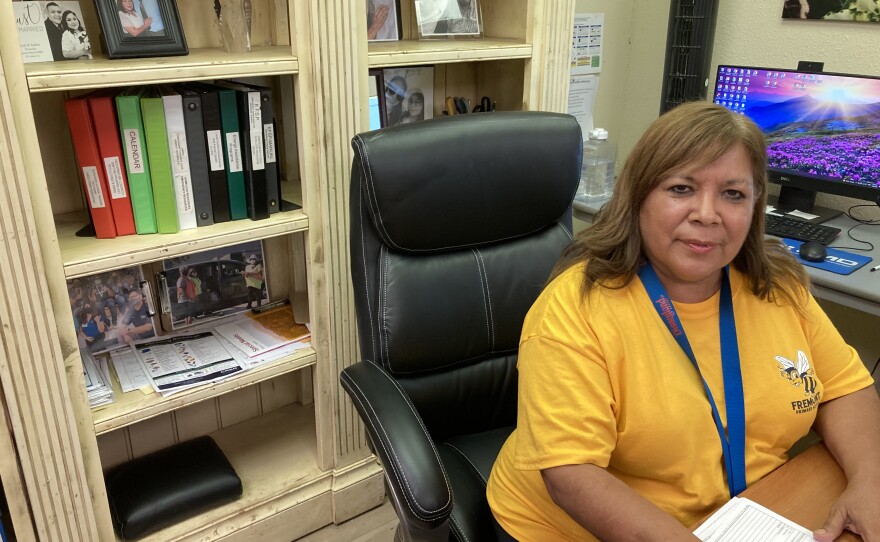The geothermal plant established by San Diego-based EnergySource looks like a refinery, sitting on the flat desert land of the Imperial Valley. It was built in the township of Calipatria in 2006, and since then, it has produced geothermal energy by extracting searing, hot water that is found underground.
But that underground lake has something more than just heat.
The water is loaded with minerals ready to be mined, including manganese, zinc and lithium. It’s lithium that has spawned a flurry of construction and speculation as the demand for lithium car batteries rockets into the stratosphere.
“We started out looking at manganese, zinc and lithium,” said Eric Spomer, the CEO of what they now call EnergySource Minerals. “But it became clear pretty quickly that all anybody wanted to talk about was lithium.”
Spomer said the business plan of EnergySource always envisioned a mining operation. Now that the focus is lithium, they are planning to build a $1 billion expansion to pull that now-precious metal from the same salty brine water that has been generating geothermal energy.
“When you ask: How do you finance a billion-dollar project? Given everything we’ve done here, that it’s fully permitted, that we have a definitive feasibility study done, it’s not about whether we can raise the money. It’s about what (the financing) is going to look like,” Spomer said.
EnergySource Minerals isn’t the only game in town. Berkshire Hathaway Energy and Australia-based Controlled Thermal Resources are also planning to mine lithium in Imperial County, using a new technical process called Direct Lithium Extraction.
People have started calling the area “Lithium Valley.” Governor Newsom has signed a bill to tax future lithium extraction, and to start splitting up the revenues between Imperial County and the effort to restore the Salton Sea.

This is happening in one of California’s most impoverished counties, where the unemployment rate has historically exceeded 20%. Local advocates say they want to be sure the “lithium gold rush” isn’t just something that benefits outside industry.
“Every time there’s an opportunity, we’ve been exploited,” said Luis Olmedo, executive director of the Comite Civico del Valle, an organization that serves farm workers and other disadvantaged communities.
“We’re going to pull together because if we don’t work together in unity, every interested party that sees a financial opportunity is going to tear us apart. And we’re going to end up with nothing but extraction, and no benefits in our own community.”
Direct Lithium Extraction: A new tool in mining.
You’ll find lithium near the top of the Table of Periodic Elements, just below Hydrogen. It’s a lightweight metal that is very efficient at storing energy. More than three decades ago, Sony began using lithium batteries in their mobile Walkman players.
Soon came smartphones and then the electric car.
Lithium mining has taken place in China and South America. It is typically done in open pit mines or through use of evaporation ponds, where lithium-rich brine water is left to dry up before the metal is taken.
Neither method is environmentally friendly. But the lithium mining that is planned for Imperial County promises to be different, using Direct Lithium Extraction (DLE).
Wearing jeans and a hardhat, Spomer shows me a shaded lot near his company’s geothermal plant where they pilot tested their own DLE technology, called ILiAD.

“It’s the cleanest lithium source in the world, and that’s not hyperbole,” he said, “compared to evaporation ponds and hard-rock mining. The carbon footprint is almost zero. The physical footprint is very small, in comparison, and the water use is very low,” he said.
At the EnergySource plant, that hot brine water that’s also used for geothermal energy will be funneled to the surface where it will be run through the ILiAD device. There, the water is pushed through a filter, also called a media.
“The media attracts the lithium ion and lets everything else pass through,” he said. “So it goes in, gets attracted to the absorbent, everything else washes through and then we come back with a lithium-spiked solution that causes all those lithium ions to be released from the absorbent.”
People in the business say the beauty of mining lithium at a geothermal plant is that the brine water is ultimately pumped back below ground, returning to the water table. Energy use is also efficient, due to the abundant supply of geothermal power.
EnergySource turned over operation of the plant to Cyrq Energy in July of this year. But EnergySource Minerals has exclusive rights to take the brine water and extract minerals from it, before Cyrq injects it back underground.
In fact, lithium mining could be the factor that makes geothermal power financially feasible. Geothermal plants are expensive to build and operate, and the energy source is being undercut by increasingly inexpensive wind and solar power.
But add lithium mining to the equation, and suddenly geothermal makes a lot more financial sense.
“If we can open up the economic viability of developing more geothermal power in this region, we can take a lot of load off the western grid because we can continue to produce very clean energy, using geothermal power,” said Carmen Rene, chief financial officer for EnergySource Minerals.
EnergySource expects their Imperial Valley plant will produce 20,000 tons of battery-specified lithium a year. But for all the promise of Direct Lithium Extraction technology, Spomer admits what they plan to do has never been done before.
“On a real commercial scale, doing pure DLE, this will be groundbreaking,” said Spomer.
Others might say it's not fully tested.
Who will profit from Lithium Valley?
Maria Nava Froelich has a comfortable, lived-in office where she works at the Calipatria school district. She is also the Mayor Pro Tem of Calipatria. She said there is a lot that is missing from her town.
“Visit our communities and see for yourself how rural and how impoverished we are. We want to thrive like other municipalities, like other communities,” Nava said.
The realities of high unemployment, lack of retail businesses and few career opportunities have been as stifling here as the triple digit temperatures. And some people in Imperial County say distribution of what money there is, has not been equitable.
Luis Olmedo, with Comite Civico del Valle, mentioned the example of the solar power development on land that used to be farms.
“The landowners get to negotiate their leases, so they get taken care of,” Olmedo said. “But because the farmworkers often aren’t organized and don’t have a very strong voice, they get sort of lost in the conversation.”
Olmedo said this time things were different.
Thanks to political pressure from the Imperial Valley the California legislature passed a law, signed by Governor Newsom, that will levy an excise tax on every ton of lithium that is recovered in the valley. That tax revenue, every cent, is staying in the county.

California assemblyman, Democrat Eduardo Garcia, who represents the Imperial Valley, tells where the money’s going to go.
“Eighty percent will go to the County for purposes of reinvestment into the community. Thirty percent of the 80% will be directed to communities closest to the lithium recovery activities,” Garcia said. “The remaining 20% will be reinvested back into Salton Sea management efforts.”
What kind of reinvestment could take place in the community?
“We heard from community residents that if you live in the North End, there are issues related to water and sewer infrastructure, “ Garcia said, referring to communities that lie close to the lithium mining projects.
“We’ve heard from community members that they’re looking for investments that will lead to economic development opportunities. There’s a town on the North End that doesn’t have a grocery store.”
Members of industry were not excited about the tax, which will ultimately reach $800 per ton of lithium recovered.
“When the governor’s office indicated they were going to support this industry, we were thankful. That’s great,” EnergySouce CEO Spomer said. “But the first thing that happened is they put a $800 a ton lithium tax on us. And I was kind of shocked that was how they were going to help this industry take off.”
But Spomer adds that his company has come to terms with the tax, and most people in the Imperial Valley are optimistic about becoming Lithium Valley.
"We think it's a game changer for our community. We think it's going to bring a lot of jobs, community benefits. We do support the excise tax," Nava Froelich said.
In a related development, San Diego State University received an $80 million check from the state to build a STEM research and education facility at its Imperial Valley campus in Brawley. Vice Provost Tong said they want to focus on science and technology subjects, and hopefully add to a growing technical industry related to mining and making lithium products.
“This is a moment in history and time when we really can transform the valley,” said SDSU President Adela de la Torre at a recent community forum.
“It’s a moment where the stars have aligned if you will, so that we can create a vision that allows our students to stay in the valley, have opportunities in the valley, and become the leader in the valley in so many different ways.”
We don’t know when that kind of future may arrive. We do know that EnergySource Minerals hopes to begin construction of their lithium mining facility by the end of this year, and start extracting the metal in 2025.
-
Residents of Imperial County are hoping for a Lithium gold rush.
-
COVID-19 booster rates remain low, just as new omicron variants of concern emerge.










